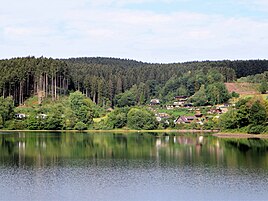Oak trees (Attendorn)
|
Oak trees
City of Attendorn
Coordinates: 51 ° 5 ′ 42 " N , 7 ° 49 ′ 44" E
|
||
|---|---|---|
| Residents : | 31 (Jun 30, 2018) | |
| Postal code : | 57439 | |
| Area code : | 02722 | |
|
Location of oak trees in North Rhine-Westphalia |
||
|
View of the Eichen district
|
||
Eichen is a district of the city of Attendorn in the Olpe district ( North Rhine-Westphalia ) and has 31 inhabitants.
geography
Eichen is located southwest of the core town of Attendorn on the north side of the Lister dam . Northeast is Wamge , east Weuste and west of the city of Meinerzhagen . The Listertalstrasse (L 708) leads past the village. North above the village is the nature reserve Eichen Quarry , a former Grauwacke quarry with excavation waters.
history
Oak was first mentioned in a document in 1401 as " de curte to den Eyken prope Attendarne ". The place name can be interpreted as " near the oaks ". On June 23, 1428, the citizen of Attendorn Johan Schepen and his wife Alike sold their free property, the farm and estate " zu den Eicken ", to Heinrich the Wecken . A year later Heinrich Weeke, who was in Bruges as a merchant for the German Hanseatic League , donated his “ Hof ten Ecken ” to the Ewig monastery under instructions .
Politically, oak was formerly part of the Waldenburg office and in the Gogericht and parish of Attendorn it belonged to the Albringhausen peasantry , which also included surrounding places such as Weuste , Wamge , Listerscheid and the like. a. belonged to. In Schatzungsregister of 1536 is a Heinrich to Eycken with an output of 3 ort (¾ Goldgulden ) out. In the register from 1565 a Peter Voss zu Eickenn is taxed with 2 ort.
According to the pension book, there were two farms in oak in the 17th century. The "topmost property" belonged to the count Kaspar Theodor Burghoff. During the Hessian period (1802–1816) the estate, called Clases Hof, was owned by the Vicarie St. Nikolai in Attendorn and was managed by Josef Luke (1781–1842), then by his son Peter (1815–1878). The family stayed on the estate until the construction of the Lister Reservoir (1909–1912) made a large part of oak trees disappear and the situation there completely redesigned. The widow of Johann Luke (1848–1899), Cordula nee, sold the remnants of the property as well as the spared house of the Claseshof. Alfes to Robert Wigger in 1912.
The "lowest good" was a genetic material and owner Johann Lütge. At the beginning of the 18th century the farm still belonged to the Lütteke family. Later it seems to have been divided, because in Hessian times there were two inherited estates, Stupperichs Hof and Groten Hof. Stupperichs Hof (Johann Stupperich) later came into the possession of the Langenohl family. After the dam was completed, Robert Langenohl had a new house built on the newly created Listertalstrasse instead of the old courtyard building that had been demolished. The owner of the Grotenhof was Johann Lütteke, then his son-in-law Josef Stuff. Since then, the estate has remained the property of the Stuff family until Wilhelm Stuff sold most of the property and the house to the Ruhrtalsperrenverband .
Around 1750 there was a hammer mill (piece hammer) on the Lister zu Eichen, operated around 1800 by Engelhard zu Olpe .
The address book from 1929 lists the names "Albus, Hesener (3), Hof, Langenohl (2), Rüsche, Wever (2) and Wigger" in Eichen. In 1936 there were 6 houses with 7 households and 43 residents in Eichen. The address book from 1956 lists the names "Hesener (3), Hirten (2), Langeohl (2), Mattern, Pfeiffer (3), Rüsche (3), Stockem, Strautz, Theiner and Wigger". At the end of 1988 the place had 34 inhabitants. Today, in addition to the residential houses, there is a holiday home area in Eichen with a view of the Lister Reservoir.
From 1819 Eichen in the Attendorn office belonged to the Attendorn-Land community until it was incorporated into the city of Attendorn in 1969.
Web links
Individual evidence
- ↑ Population statistics of the city of Attendorn (as of June 30, 2018) , accessed on August 4, 2018.
- ^ Johann Suibert Seibertz: Document book for the regional and legal history of the Duchy of Westphalia I, No. 484, page 607
- ↑ Michael Flöer: The place names of the district of Olpe , in: Westfälisches Ortsnamenbuch, Volume 8, Bielefeld 2014, page 86
- ↑ Norbert Scheele (Ed.): Regesten of the former Ewig Monastery , Olpe 1963, Urk 51 page 14, Urk 53 page 15
- ↑ The 16th century appraisal registers for the Duchy of Westphalia, Part 1 (1536 and 1565), page 218
- ↑ Julius Pickert: The farms of the Attendorn parish in the 17th century , in: Heimatblätter des Kreis Olpe, 4th century. 1926/27, page 18
- ↑ Hubert Luke: Court and clan history of the hatches in the Attendorner area since 1808 , self-distribution Biekhofen 1997, page 3
- ^ Franz Sondermann: History of the iron industry in the Olpe district , Münster 1907, page 71
- ↑ Official address book of the Olpe district 1928/29, section Attendorn-Land municipality, page 77
- ↑ Official residents' register of the district of Olpe 1938, Attendorn Office, page XV
- ↑ Home address book of the district of Olpe, Münster 1956, section Attendorn-Land, page 147
- ^ Association for Orts- und Heimatkunde Attendorn eV, bulletin no. 14 (1990), page 15


